Click on images to enlarge

infestation (Photo: Sheldon Navie)
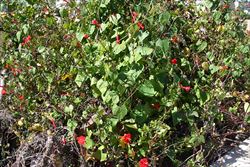
habit (Photo: Sheldon Navie)

habit (Photo: Sheldon Navie)

close-up of leaf (Photo: Sheldon Navie)
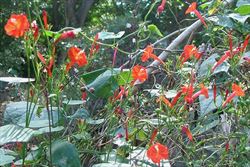
scarlet red flowers (Photo: Sheldon Navie)
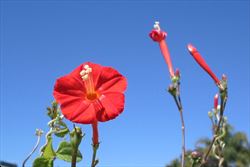
flowers and flower buds (Photo: Sheldon Navie)
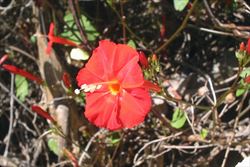
close-up of flower (Photo: Sheldon Navie)
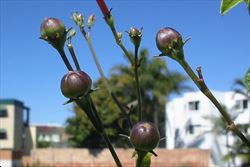
close-up of immature fruit (Photo: Sheldon Navie)

mature fruit (Photo: Sheldon Navie)
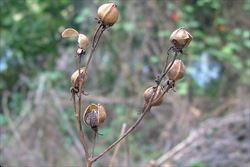
close-up of mature fruit (Photo: Sheldon Navie)
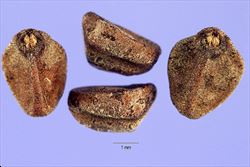
close-up of seeds (Photo: Steve Hurst at USDA PLANTS Database)

young plant (Photo: Sheldon Navie)
Scientific Name
Ipomoea hederifolia L.
Synonyms
Ipomoea angulata Lam.
Family
Convolvulaceae
Common Names
ivy-leaf morning glory, red convolvulus, red flowered bellvine, redstar, scarlet creeper, scarlet morning glory, scarlet morning-glory, scarlet morningglory, scarletcreeper, star ipomoea, star morning-glory, trompillo
Origin
Native to south-eastern USA (i.e. Alabama, Florida, Georgia, Mississippi and Texas), Mexico, Central America (i.e. Costa Rica, Guatemala, Nicaragua and Panama), the Caribbean (i.e. the Dominican Republic, Haiti and Jamaica) and South America (i.e. Guyana, Venezuela, Brazil, Bolivia, Colombia, Ecuador, Peru and Paraguay).
Naturalised Distribution
This species is widely naturalised in northern and eastern Australia. It is most common and widespread in the coastal districts of northern and central Queensland. Also naturalised in other parts of Queensland, in the coastal districts of northern and central New South Wales, in the north-eastern parts of the Northern Territory, on Christmas Island, and in the Kimberley region in northern Western Australia.
Widely naturalised in other parts of the world, including on several Pacific islands (e.g. Fiji, Nauru, Hawaii, Palau, New Caledonia and Tonga).
Notes
Red convolvulus (Ipomoea hederifolia) is regarded as an environmental weed in northern Queensland and as an emerging or potential environmental weed in northern Western Australia and the Northern Territory. It is has escaped cultivation and is an occasional weed of bushland and riparian areas, as well as sugarcane, roadsides, gardens, disturbed sites and waste areas.
Red convolvulus (Ipomoea hederifolia) is becoming increasingly abundant in northern Queensland, and it is now regarded as a pest plant by the Cairns City Council. It is also listed as an environmental weed of the Burdekin Dry Tropics region in central Queensland. This species has been recorded in the Bowral and Kyogle districts in New South Wales, and is also present in the Narran Lake Nature Reserve in the North-Western Plains region of this state.

